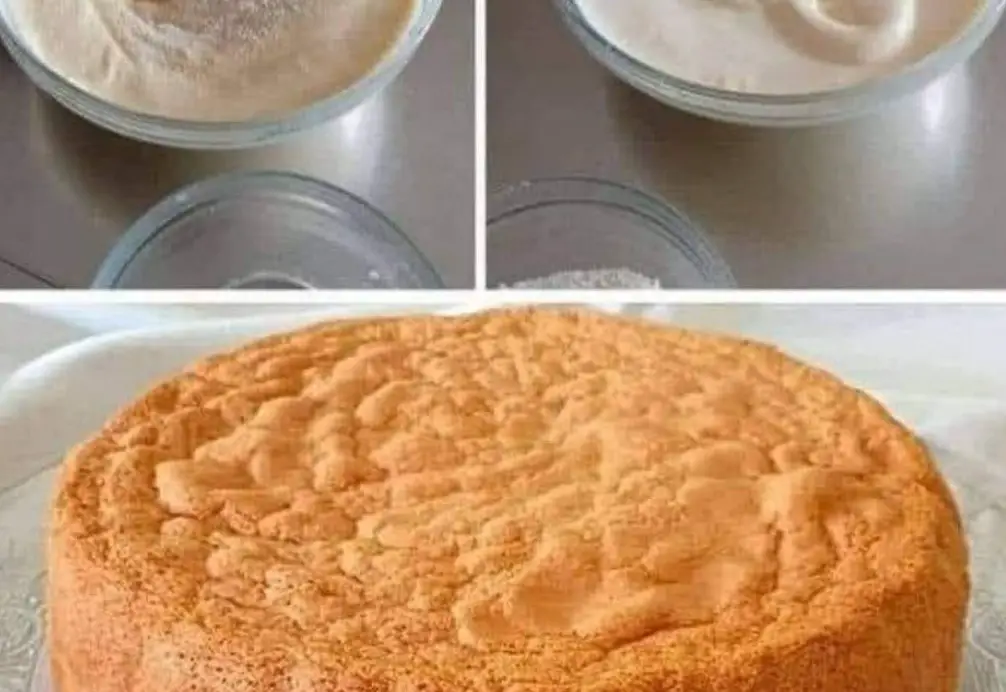Sponge cake is a delightful treat known for its light, airy texture and simple yet delicious flavor. With just a few basic ingredients and straightforward steps, you can create a homemade sponge cake that’s perfect for any occasion. This recipe requires only four eggs, granulated sugar, and all-purpose flour, making it easy to whip up whenever you’re in the mood for a sweet indulgence.
Ingredients:
For this sponge cake recipe, you’ll need:
- 4 eggs
- 1 cup (200g) granulated sugar
- 1 cup (120g) all-purpose flour
Directions:
- Begin by preheating your oven to 350°F (175°C). Grease and line the bottom of a round cake pan with parchment paper to prevent the cake from sticking.
- In a large mixing bowl, crack the eggs and add the granulated sugar.
- With an electric mixer, beat the eggs and sugar together on medium-high speed for approximately 8-10 minutes. The mixture should become thick, pale, and triple in volume, creating a fluffy texture.
- Sift the all-purpose flour into the egg mixture in small batches. Using a spatula, gently fold the flour into the batter, taking care not to overmix. It’s essential to maintain the airiness of the batter for a light sponge cake.
- Once the flour is fully incorporated, pour the batter into the prepared cake pan, spreading it evenly.
- Bake the cake in the preheated oven for about 25-30 minutes, or until the top is golden brown and a toothpick inserted into the center comes out clean.
- Remove the cake from the oven and allow it to cool in the pan for 5 minutes. Then transfer it to a wire rack to cool completely.
- Once cooled, your sponge cake is ready to be enjoyed! You can serve it as is or get creative by adding whipped cream, fresh fruit, or your favorite frosting as toppings.
Tips:
- Beating the eggs and sugar until they triple in volume is crucial for achieving the desired lightness and texture of the sponge cake.
- When folding the flour into the batter, do so gently to avoid deflating the air bubbles that give the cake its airy consistency.
- Ensure the cake is fully cooled before slicing and serving to maintain its structure and prevent it from crumbling.
Conclusion:
With its minimal ingredients and straightforward preparation, this three-ingredient sponge cake is a versatile dessert option that’s sure to impress. Whether you enjoy it on its own or with your favorite toppings, this homemade treat is bound to satisfy your sweet cravings. Give this recipe a try and indulge in the delightful simplicity of a classic sponge cake!
- Why is my sponge cake dense and not light and fluffy?
- Dense sponge cake can result from several factors. One common reason is overmixing the batter, which deflates the air bubbles essential for creating a light and fluffy texture. Ensure you gently fold the flour into the batter just until incorporated to maintain the airiness. Additionally, using cold eggs or not beating the eggs and sugar mixture adequately can also lead to a dense cake. Be sure to beat the eggs and sugar until they triple in volume and reach a thick, pale consistency before adding the flour.
- Can I substitute other types of flour for all-purpose flour in this recipe?
- While all-purpose flour is traditionally used in sponge cake recipes, you can experiment with alternative flours such as cake flour or self-rising flour. Cake flour tends to produce a softer and more tender crumb due to its lower protein content. Self-rising flour contains baking powder and salt, which may affect the rise and flavor of the cake. If substituting, consider adjusting the recipe proportions and baking time accordingly to achieve the desired texture and taste.
- How do I prevent my sponge cake from sticking to the pan?
- Properly greasing and lining the cake pan with parchment paper can help prevent the sponge cake from sticking. Ensure you coat the entire inner surface of the pan with butter or cooking spray, and then place a parchment paper round at the bottom before pouring in the batter. Once the cake is baked, allow it to cool in the pan for a few minutes before gently running a knife around the edges to loosen it. Inverting the pan onto a wire rack and tapping the bottom can help release the cake without damaging its structure.
- Can I make adjustments to the recipe to add flavor variations to the sponge cake?
- Absolutely! Sponge cake serves as a versatile base for incorporating various flavors and enhancements. You can add extracts such as vanilla, almond, or lemon to the batter for a subtle flavor boost. Additionally, consider folding in zest from citrus fruits or adding spices like cinnamon or nutmeg for a more aromatic profile. For a richer taste, you can incorporate melted butter or substitute part of the sugar with cocoa powder for a chocolate sponge cake. Experiment with different flavor combinations to customize the sponge cake according to your preferences.

